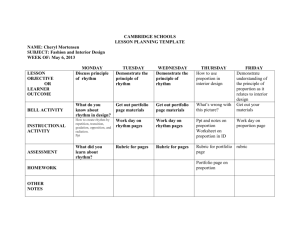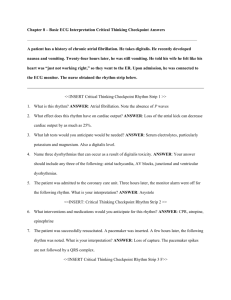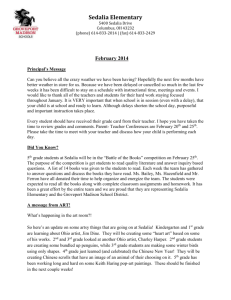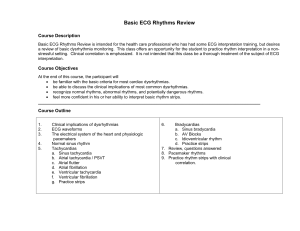Clap a rhythm in response to visual stimulus (symbols):
advertisement
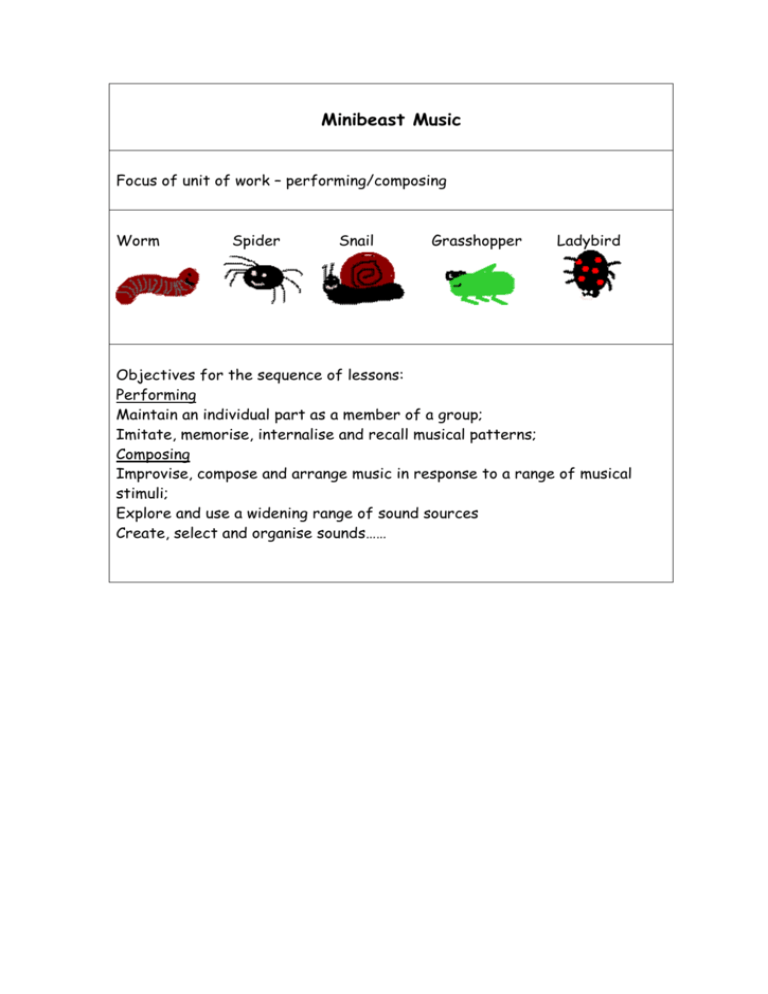
Minibeast Music Focus of unit of work – performing/composing Worm Spider Snail Grasshopper Ladybird Objectives for the sequence of lessons: Performing Maintain an individual part as a member of a group; Imitate, memorise, internalise and recall musical patterns; Composing Improvise, compose and arrange music in response to a range of musical stimuli; Explore and use a widening range of sound sources Create, select and organise sounds…… Activity Bank for Rhythm 1 These activities establish the main rhythm patterns used in the unit of work. It is important to spend time at the outset making sure that the pupils have learnt each of the rhythms and can play them on classroom instruments. Introduce symbols – demonstrate how to clap each rhythm: Worm – - crotchet (1 beat) Spider – ♫ - quavers (= 1 beat) Snail – - minim (2 beats – pronounced sna-ail). Grasshopper – - quaver + 2 semiquavers (= 1 beat altogether) Starter activity – practice clapping each rhythm several times saying the words aloud whilst clapping (whole class). Split class into 4 groups – Group 1 starts by clapping (e.g. worm, worm, worm, worm etc. Group 2 then joins in with spider, spider… whilst 1st group continues – groups 3 and 4 join in gradually). Decide on start/stop signals, dynamics etc. As above, working in groups of 4 so that pupils have an individual part. Encourage pupils to dispense with saying the words aloud as they become more familiar with the rhythms. Choose some groups to demonstrate to rest of class. In groups, use untuned percussion instruments to improvise using the rhythm patterns. Groups to perform their improvisations for the rest of the class. Main (improvised) group composition activity: using a variety of tuned + untuned instruments and the notes of the pentatonic scale (CDEFGA), compose a short piece using the rhythms learnt. Plenary – Appreciation session. Listen to each group’s composition (+ tape record if possible). Discuss – which group’s compositions work best and why. (e.g. effective ways of starting/finishing, keeping the beat, dynamics etc etc.) Screen 2 Listen to the recording of “Morfa Rhuddlan” and follow the rhythm of the music (using the red dot to help keep in time). The pupils can “score read” by quietly saying the names of the minibeasts whilst listening to the music. (midi file used by courtesy of Barry Taylor - grateful thanks). http://www.contemplator.com/tunebook/wlshmidi.htm. Clive Buckley, School of Education and Humanities Athrofa Addysg Uwch Gogledd Ddwyrain Cymru North East Wales Institute of Higher Education, Wrexham, North Wales Activity Bank for Rhythm 2 Before showing pupils flipchart 2, revise rhythm patterns from previous lesson. Explain that rather than improvise rhythms, they will be reading from the symbols this lesson. Uncover flipchart 2 (use screen shade to reveal one line at a time) and clap through as a class, in groups, individuals, as a round etc. Pupils should practise with different groups clapping different lines at the same time. Pupils work in groups of 3, taking turns to be the leader. Listening activity - Groups to perform for rest of class – can the other pupils identify who was clapping lines 1, 2 and 3? Composition activity – 1 child to demonstrate how to select rhythms (drag into boxes) for their own piece. Class to clap the pupil’s composition whilst they conduct. Explain that this is different from last lesson’s composition (which was an improvisation), as we have now recorded the piece so that other people can play it. Other pupils compose using the IWB. Use untuned classroom instruments for pupils to practise playing other pupils’ compositions they read from the IWB. Written composition activity – using worksheet 1, compose a short rhythm poem using the minibeast symbols. Play it on classroom instruments, swap with partners to see if they can read each other’s music. Perform for rest of class. Extension activity – using notes of pentatonic scale as before, compose and perform a piece where the rhythm is read from the symbols, but the pitch is improvised. Activity Bank for Rhythm 3 Similar activities to previous lessons, but ensure that the pupils become familiar with the new rhythm and can use it in their compositions. Introduce new rhythm (ladybird – 1 beat, 2 semiquavers + quaver) Clap through the 3 lines of rhythm (using screen shade) as in previous lessons. The rhythms are now becoming more complicated and will need practising carefully so that the pupils can use them confidently and keep in time with each other. Screen 2 - pupils to compose using IWB – class to clap/ play using classroom instruments. Listening activity: The teacher should choose a piece of music with which the children are already very familiar, e.g. “Mae Hen Wlad fy Nhadau” or a song / hymn they have learnt. Using pictures that have been saved into the gallery, (see gallery notes at bottom of the page) pupils can drag the correct minibeast pictures onto Screen 3 (which is blank to start with) so that the class can “score read” the extract as they sing the song. Discuss how simple the rhythm is for the song they have chosen. Children are often tempted to select complicated, frequently-changing rhythm patterns for their own compositions and are surprised at how uncomplicated most songs are. “Mae Hen Wlad fy Nhadau”, for example, uses mainly “worms” (crotchets), with the occasional “spider” and snail”. Extension Activity: can the pupils drag the traditional notation (instead of the minibeast symbols) onto the IWB? Written Activity / Homework: using either symbols or traditional notation, write down the rhythm of a song of their choice – e.g. “Baa Baa Black Sheep”. (Worksheet 2) Activity Bank for Rhythm 4 Sound file used by courtesy of Jim Paterson: mfiles – the music files http://www.mfiles.co.uk Introduce the correct musical notation to correspond to the symbols they have been using. Discuss syllables – this will sort out most of the rhythm patterns. The crotchet/minim will have to be explained by the teacher as they both have only one syllable. Discuss the stave – explain that reading music is just a matter of learning how to match the symbols to the sound. Drag the correct pictures to the notation on screen 1. Screens 2 and 3 are also matching activities. Before playing the excerpt from “Autumn” (Vivaldi – The Four Seasons) ,ask the children to clap the rhythm using the symbols depicted on screen 4. Listen to the music – had they successfully worked out the rhythm? Discuss the form – how certain sections are repeated. They should use this technique in their own compositions to give their music shape. The children can now start to use rhythm notation to record their own rhythm compositions. As they listen to pieces of music, they should be able to recognise and jot down (either as pictures or using notation) many of the rhythm patters they hear. A wide range of music can be used to practise and develop this skill. Activity Bank for Rhythm 5 Midi file used by courtesy of Barry Taylor - grateful thanks. http://www.contemplator.com/tunebook/wlshmidi.htm. Clive Buckley, School of Education and Humanities Athrofa Addysg Uwch Gogledd Ddwyrain Cymru North East Wales Institute of Higher Education, Wrexham, North Wales Sing/listen to Llwyn Onn in Welsh or English (The Ash Grove). Try to elicit from the pupils which rhythms are used. Use the composition grid sheet to work out the rhythms used and then rearrange the symbols on the screen to correspond to the rhythms in the song. (Enough symbols are on the screen for the first verse of the song). Lyrics for the Welsh and English versions of this song can be found at http://ingeb.org/songs/allhailt.html Use the notation symbols to drag the correct musical notation to match the symbols on the screen. Composition activity using tuned percussion instruments / keyboards: Keeping the same rhythm as Llwyn Onn, choose differently pitched notes to produce new pieces of music. This activity may be either improvised or worked upon individually / in groups. Activity Bank for Rhythm 6 Sound file used by courtesy of Jim Paterson: mfiles – the music files http://www.mfiles.co.uk The two screens in this Flipchart are used to annotate the rhythms for an extract from Beethoven’s 7th Symphony. Screen 1 uses symbols, screen 2 uses notation. Whilst listening to the music, drag the correct symbols/musical notation into the grid. Again, discuss the simplicity of the rhythm in this piece of music. Play a recording of the whole movement and listen to Beethoven’s use of rhythm. Listen out for and discuss the amount of repetition. Compose a piece of music using the same rhythmic pattern. (worksheet 2) Activity Bank for Rhythm 7 Sound file used by courtesy of Jim Paterson: mfiles – the music files http://www.mfiles.co.uk Mozart – Alla Turca Introduce the new rhythm: Caterpillar - 4 semiquavers = 1 beat. Practise clapping the rhythm – firstly on its own, then against other rhythm patterns already covered in earlier lessons. This is a “fun” listening activity as it is a very fast piece of music! The symbols on the screen show the main rhythmic patterns and the children should try to move the orange dot up and down the left hand side of the screen to select the correct line as the music is playing. They will enjoy (quietly!) whispering the rhythms whilst the music is playing – especially the “Caterpillar……” section at the end! Gallery pictures A selection of minibeast pictures have been provided so that teachers can add them to the gallery and use them to drag onto the screen as needed. To save the pictures into the gallery; click on the gallery tab Click on this icon in the top right hand corner of the screen Then click ‘Add other files to my content’ Navigate to the correct file that contains the pictures and double click on one to add it to the gallery



